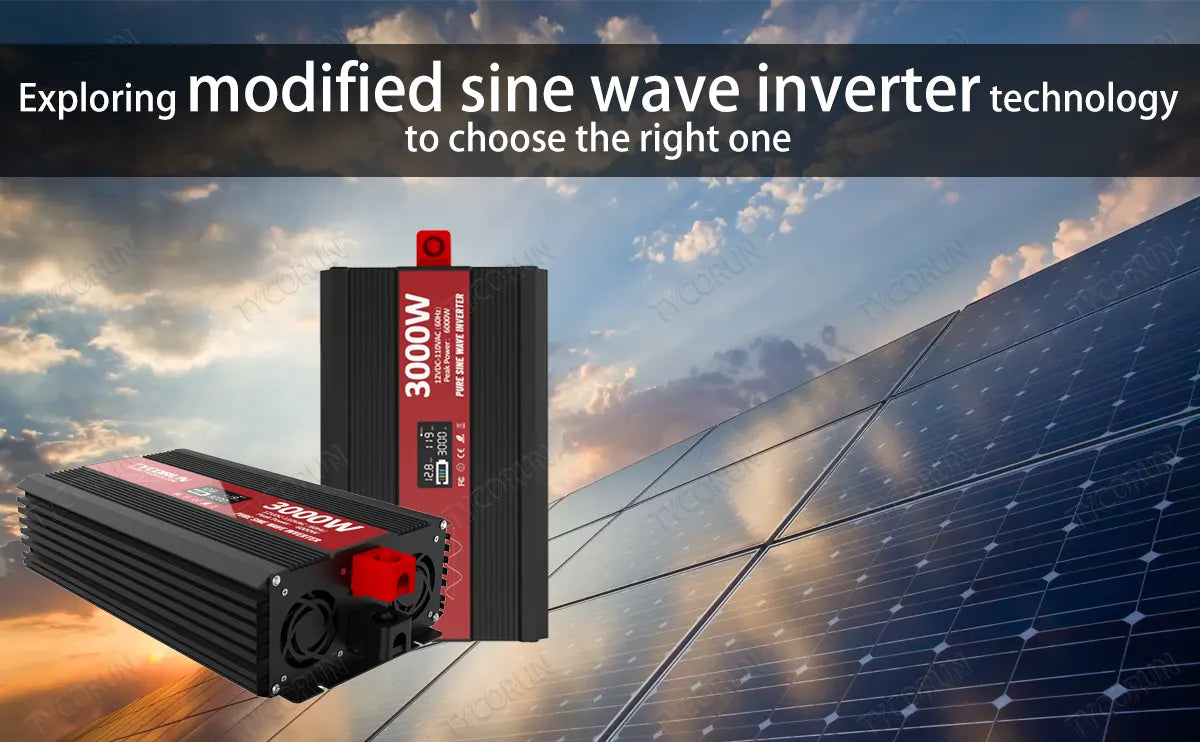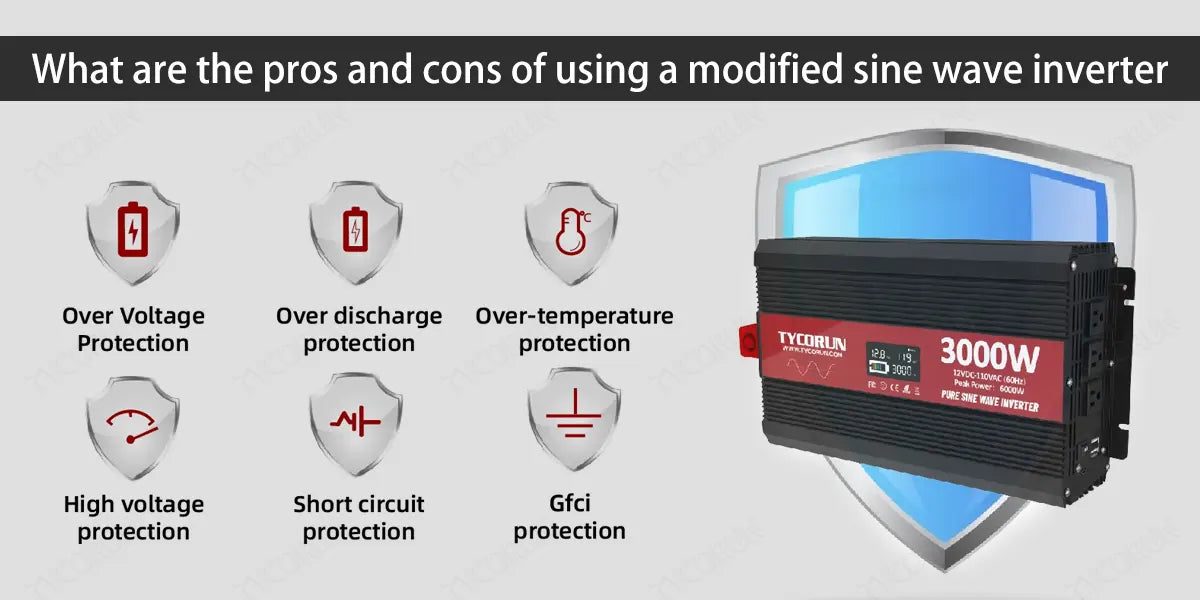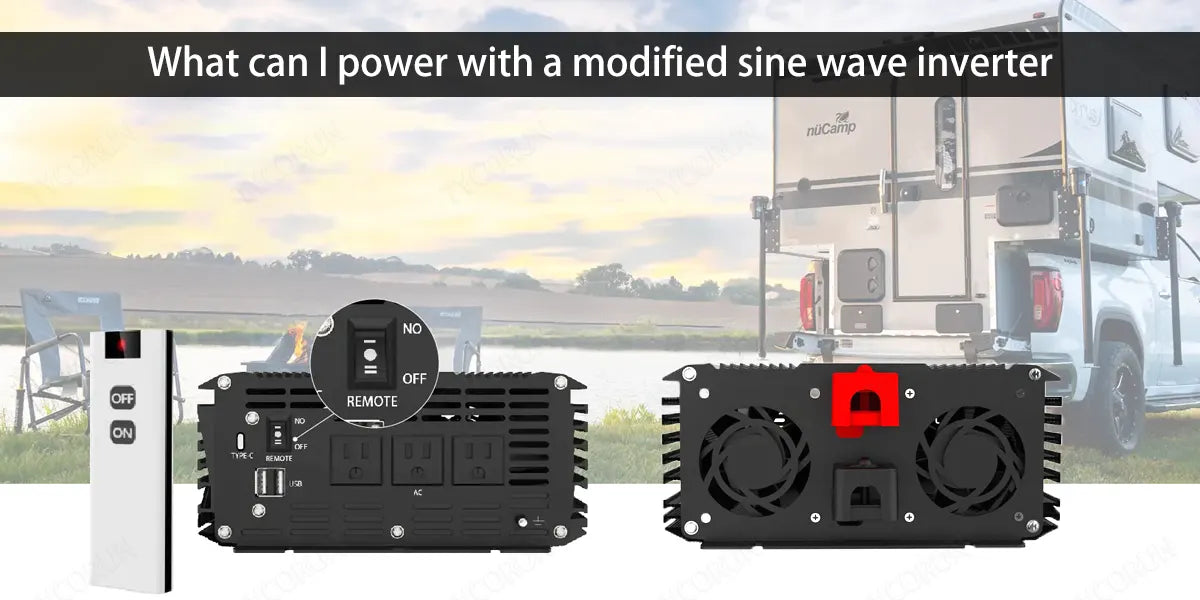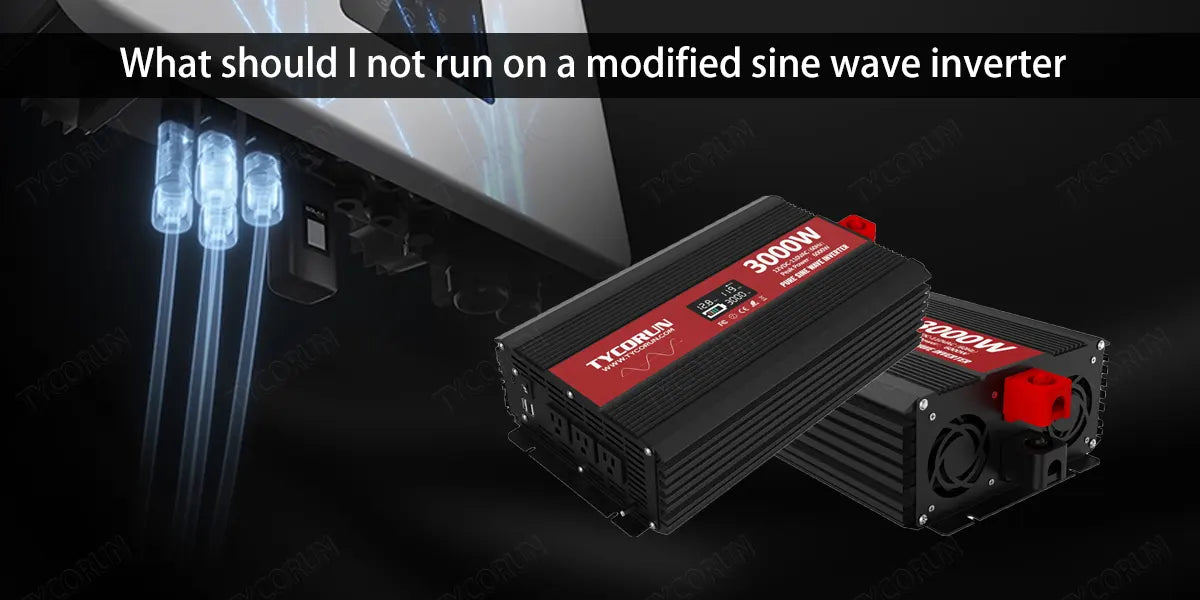
Main content:
- What is a modified sine wave inverter
- What are the pros and cons of using a modified sine wave inverter
- What is the efficiency of a modified sine wave inverter
- What can I power with a modified sine wave inverter
- What should I not run on a modified sine wave inverter
- What are the limitations of a modified sine wave inverter
- Which is better pure sine wave or modified sine wave inverter
- How to buy the best modified sine wave inverter
- Top 3 inverters recommended - for the best price
- FAQs about modified sine wave inverter
- Is modified sine wave OK for LED lights
- Will a modified sine wave inverter damage my electronics
- Will a modified sine wave inverter run a microwave
- Conclusion
Dive into the realm of modified sine wave inverter with this guide. From lighting LEDs to running microwaves, we break down critical factors like power requirements, compatibility, and brand reliability.
Whether you're a tech enthusiast or a homeowner, this article simplifies the decision-making process for an efficient and reliable energy conversion experience.
1. What is a modified sine wave inverter
Here, a modified sine wave inverter is a gadget that changes the type of electricity that gives out from a DC power source. While it might not be as perfectly smooth as the electricity from a wall outlet, it does the job for some basic devices.
Imagine you have a device at home that needs electricity, like a laptop or a blender. Now, regular household electricity flows smoothly, curly, like rolling hills.
A modified inverter is like a helper that takes a more straightforward path, like stepping up and down stairs instead of smoothly going up and down hills. The working principle of inverter is similar.
2. What are the pros and cons of using a modified sine wave inverter
● Pros- Cost-effective
Modified sine wave inverters are generally more affordable than pure sine wave inverters, making them a budget-friendly option for basic power needs.
- Efficiency for basic devices
Many common household appliances and electronics, such as lights, fans, and simple tools, can operate efficiently with a modified sine wave, making these inverters suitable for everyday use.
- Compact and lightweight
These inverters are often smaller and lighter than their pure sine wave counterparts, making them more portable and easier to handle.

● Cons
- Limited compatibility
Some sensitive electronics and advanced devices do not function optimally with a modified sine wave, and even prone to damage.
- Potential for increased heat
The waveform produced by modified inverters can cause specific devices to run less efficiently and generate more heat, impacting their lifespan.
- Reduced efficiency
While they are generally efficient for essential appliances, they may be less energy-efficient than pure sine wave inverters. This can result in slightly higher power consumption for some devices.
- Noise or interference
Certain audio and visual equipment may experience noise or interference when powered by a modified sine wave, affecting performance and quality.
In summary, understanding the specific needs of your devices will help you determine whether a modified sine wave inverter is the right choice for your situation.
3. What is the efficiency of a modified sine wave inverter
The efficiency of a modified sine wave inverter can vary depending on factors such as the quality of the inverter, the specific design, and the load it is powering. Modified sine wave inverters are generally considered less efficient than pure sine wave inverters.
Here's the basic formula for efficiency:
Efficiency (%) =(Output Power\Input Power)×100
It's important to note that the efficiency may vary at different load levels.
4. What can I power with a modified sine wave inverter
A modified sine wave inverter can power various primary electronic devices and appliances. The applications of inverter is wide. Here's a list of everyday items that it can generally power:

- Lights: Incandescent, LED, and fluorescent lights work well.
- Fans: Regular household fans can be powered without issues.
- Small kitchen appliances: Kitchen gadgets like blenders, toasters, and coffee makers work with modified sine wave power.
- TVs and audio equipment: Standard televisions, DVD players, and audio equipment are often compatible. But it is easy to make noise.
A modified inverter supports devices like power tools, heating pads, and certain pumps. Always verify specific device requirements before connecting them to the inverter.
5. What should I not run on a modified sine wave inverter
Here are some examples of items you should avoid running on a modified sine wave inverter:
- Sensitive electronics
Devices like laptops, computers, and other sensitive electronics may not function optimally or experience reduced performance. Using a pure sine wave inverter for such equipment is generally better.
- Medical equipment
Critical medical devices such as CPAP machines, electronic oxygen concentrators, and specific medical monitors may not be compatible.
- Refrigerators and freezers
Some refrigerators and freezers, especially those with variable-speed compressors, may not work efficiently on a modified sine wave and could experience damage over time.
- Air conditioners
Air conditioning units with variable-speed compressors or electronic controls may not operate properly on a modified sine wave, and their performance could be compromised.

Specific power tools, especially those with electronic speed control and solar battery chargers for high-end devices, may not work well.
Laser printers, high-end audio/video equipment, and microwaves may also experience issues or damage. It's safer to use a pure sine wave inverter for devices with critical power requirements.
6. What are the limitations of a modified sine wave inverter
- Limited compatibility
Not suitable for sensitive electronics like laptops and computers. It may cause issues with devices requiring a clean power supply.
- Reduced efficiency
Some appliances with motors or compressors may not operate efficiently. Increased heat generation in specific devices.
- Noise or interference
Audio and visual equipment may experience noise or interference. The quality of signals for amplifiers, speakers, and televisions may be affected.
- Incompatibility with variable-speed motors
Power tools and appliances with variable-speed motors may not function properly.
- Not ideal for medical equipment
Critical medical devices with specific power requirements may not be compatible.
- Limited suitability for refrigerators and air conditioners
Specific models with variable-speed compressors or electronic controls may not operate efficiently.
- Higher total harmonic distortion (THD)
The modified sine wave has higher THD, affecting the quality of power supplied.
7. Which is better pure sine wave or modified sine wave inverter
Here's a simple comparison table between modified sine wave and pure sine wave inverters that you can see the difference directly and easily.
|
Feature |
Pure sine wave inverter |
Modified sine wave inverter |
|
Waveform |
Smooth and identical to utility power |
Modified, with steps and sharp edges |
|
Compatibility |
Ideal for all types of devices |
Suitable for some basic devices, but not suitable for sensitive electronics or devices with motors/compressors. |
|
Efficiency |
Typically higher efficiency |
Generally slightly lower efficiency |
|
Device lifespan |
Generally extends device lifespan |
It may generate more heat, potentially impacting device lifespan |
|
Cost |
Higher cost |
More cost-effective |
|
Noise/Interference |
No interference |
May produce noise in audio/visual equipment |
|
Applications |
Recommended for sensitive electronics, medical equipment, and high-end appliances |
Suitable for basic appliances, lights, and tools; not ideal for sensitive electronics or devices with specific power requirements |
|
Heat Generation |
Lower heat generation |
May generate more heat in some devices |
|
Total Harmonic Distortion (THD) |
Low THD, providing clean and stable power |
Higher THD, affecting power quality |
|
Portability |
Slightly larger and heavier |
Compact and lightweight |
8. How to buy the best modified sine wave inverter
Select an PV inverter with sufficient capacity for your devices' power needs. Choose a reputable brand with safety features like overload and short circuit protection.

Check for the correct input and output specifications, consider portability for mobile setups, and ensure the inverter type aligns with your devices.
Look for high efficiency, read user feedback, and compare value prices. Also, confirm ease of installation and check warranty and customer support for added assurance in your decision-making.
9. Top 3 inverters recommended - for the best price
- Renogy
Renogy is known for its reliable inverters and solar power solutions. They offer a range of inverters suitable for various applications, and their products are often praised for their durability and performance.
- Tycorun
Tycorun is known for its inverters and power solutions. They offer a variety of inverters, and many users appreciate their products' combination of quality and affordability.
|
|
500w
|
1000w |
2000w
|
3000w
|
|
Product image
|
||||
|
Price & Discount
|
$49.9(-29%)
|
$98.99(-29%)
|
$199.90(-20%)
|
$229.00(-23%)
|
|
Rated Input Voltage
|
12VDC
|
12VDC
|
12VDC
|
12VDC |
|
Continuous Power
|
500w
|
1000w
|
2000w
|
3000w |
|
Peak Power
|
1000w |
2000w |
4000w |
6000w |
|
More information |
Click to get the details |
Click to get the details |
Click to get the details |
Click to get the details |
- KRIËGER
KRIËGER is recognized for its power inverters, including modified and pure sine wave models. They are often praised for providing affordable yet dependable inverters for both home energy storage and automotive use.
Remember that availability, pricing, and product features can change over time, so checking the latest reviews, specifications, and prices is reasonable before purchasing.
10. FAQs about modified sine wave inverter
① Is modified sine wave OK for LED lights
Yes, modified sine wave inverters are generally suitable for powering LED lights. LED lights are less sensitive to the power supply quality than other electronic devices.
② Will a modified sine wave inverter damage my electronics
A modified sine wave inverter does not be suitable for all electronics. While essential devices usually work delicately, sensitive electronics like computers and audio equipment might experience issues or damage. Motor-driven devices and appliances may also be less efficient.
③ Will a modified sine wave inverter run a microwave
A modified sine wave inverter can usually run a basic microwave, but there may be efficiency issues. Check your microwave's specifications and consider a pure sine wave inverter for optimal performance if the microwave has advanced controls or features.
11. Conclusion
In wrapping, modified sine wave inverters offer a budget-friendly and versatile energy solution. Yet, being aware of compatibility issues is essential, especially with sensitive gadgets.
Whether brightening your space or using a microwave, understanding power needs and user feedback ensures a trustworthy energy setup. Balancing cost-effectiveness with device compatibility is the key to a hassle-free power experience. Cheers to smooth energy use!
Tycorun has a diverse selection of inverters to cater to multiple requirements and applications. Their usual product lineup includes:3000w inverter, 2000 w power inverter, 1000 watt power inverter, 500 watt power inverter
Related articles: best batteries for off grid solar, distributed pv system, top 10 PV inverter companies




















